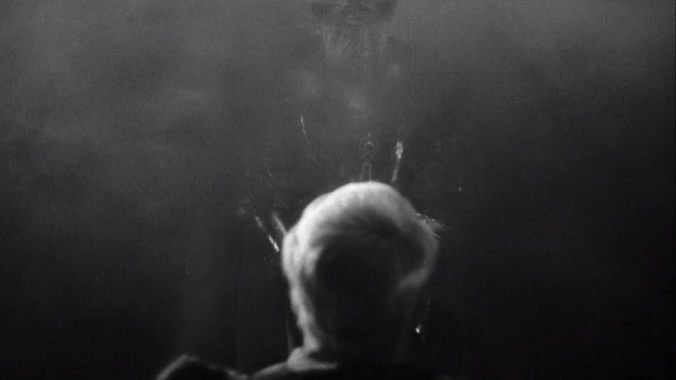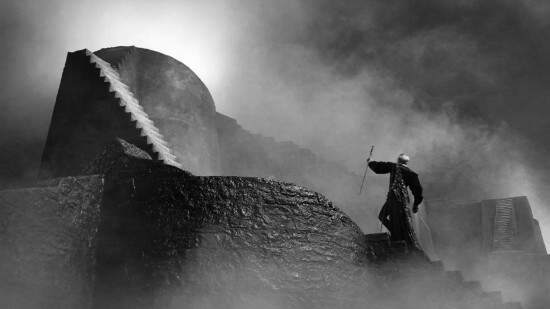With Ghoulish Sound and Noirish Style, Laurence Olivier Brought Hamlet to the Movies

Imagine having never seen Hamlet. Knowing about it, maybe even having gone through it in school—glassy-eyed classmates popcorn reading its couplets around the room, stumbling o’er the “o’ers”—but never truly feeling the emotional, sensational breadth of its power. For most of its existence, it carried whatever connotation your local troupe (if you had one) gave it. But for so many, the potency of live performance was balanced against its scarcity—and overtaken by the wide-release, perfectionist quality control of cinema. Managing and capturing every minute detail, Hamlet on film allows its Dane to mutter and fester forever. Stuck on celluloid, he is a perpetual motion machine of melancholic madness. Wielded by Laurence Olivier, one of Shakespeare’s best performers, and distributed in its most consistent form, that energy ignites us.
75 years ago, Olivier’s Hamlet was the first time many had ever heard the play performed. It was the first time an English-language Hamlet had ever been filmed in sound (Khoon Ka Khoon, Sohrab Modi’s Hindi/Urdu film, preceded it by 13 years, but never quite made it to Peoria) and the deliveries of Olivier’s players enlivened Shakespeare’s words beyond their static beauty. Olivier—directing himself as a venomous, ironic, honorbound hero in the title role—won the Oscar for Best Actor. Jean Simmons’ girlish Ophelia and Felix Aylmer’s blustery Polonius parse even the densest prose into uncanny whimsy or pompous punchlines. But the cast’s combined mastery cowers in the face of the adaptation’s most striking feat: The Ghost.
The phantom of Hamlet’s murdered father dominates the first act, giving Hamlet his mission and planting the supernatural seeds of insanity deep in the loam of his psyche. It’s always been a hit in the play; ghosts are cool, externalize inner turmoil, and allow for expressionism in a story anchored by earthly sins. You can experiment with light and sound on stage, shadowing or fogging the specter and playing his voice from a recorder, but Olivier’s techniques innovate while encapsulating his film’s noirish, horror-filled aesthetic.

Released just two years after French critic Nino Frank coined the phrase “film noir,” Hamlet smashed moody, muddy post-war psychology into the stark, unreal settings of German expressionism. Hamlet might not have a cigarette dangling from his lips or be packing heat, but the conflict tearing him apart might as well be wrestling inside a Humphrey Bogart antihero. Olivier’s horny, cruel, pithy performance—replete with voiceover for any asides—inches along a moral tightrope. The setting he navigates gives us clear images of his clouded mental state. As Olivier’s opening voiceover reminds us: “This is the tragedy of a man who could not make up his mind.”
His mind is mapped out, its uncomfortable floor plan laid bare. Throughout the film, Desmond Dickinson’s camera glides through the spartan corridors and tight doorways of Hamlet’s castle. Stripped of regal finery, the meat of the story is as confined by the keep’s walls as Hamlet is by his own vengeful quest. The one time we flee the castle, the character we accompany drowns. Hamlet is sparsely decorated and, even in the safe, well-lit halls of royalty, nearly abstract in its misty, cerebral architecture. But nothing is as evocative as the smooth Escher-like parapets he wanders after hearing a rumor of his father’s restless spirit. Labyrinthine and useless, they meander and weave and obscure, as disjointed as the jagged rooftops in The Cabinet of Dr. Caligari.

Up on these battlements, where Hamlet faces down death, Olivier best displays what Hamlet can do in this medium.
As the Ghost approaches, Olivier combines a pulsing heartbeat sound effect (co-opted from Jean-Louis Barrault’s stage production) with a cacophony of howls. This sound was the product of “as many as fourteen separate sound tracks,” that included “fifty women shrieking,” “the groans of as many men,” and “a dozen violinists scraping their bows across the strings on a single screeching note.” Mixing these, Olivier and his team created a noise that the filmmaker said resemble “the lid of hell being opened.”
-

-

-

-

-

-

-

-

-

-

-

-

-

-

-

-

-

-

-

-

-

-

-

-

-

-

-

-

-

-

-

-

-

-

-

-

-

-

-

-








































